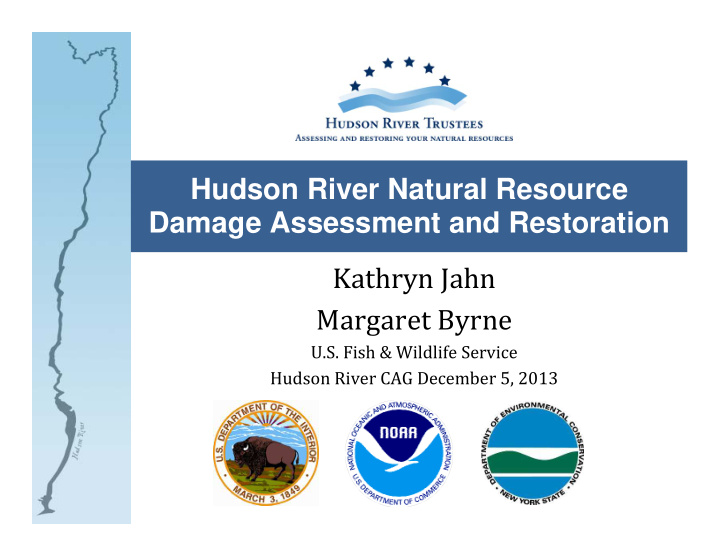



Hudson River Natural Resource Damage Assessment and Restoration Kathryn Jahn Margaret Byrne U.S. Fish & Wildlife Service Hudson River CAG December 5, 2013
Cleanup and Restoration Efforts • EPA: Superfund – clean up hazardous substances to protect the environment and public health. • Trustees: Natural Resource Damage Assessment – assess, and restore or replace natural resources injured by hazardous substances to provide for the public’s use and enjoyment.
Hudson River Natural Resource Trustees New York State, represented by the Department of Environmental Conservation ( NYSDEC ) U.S. Department of the Interior (DOI), represented by the U.S. Fish and Wildlife Service ( USFWS ) U.S. Department of Commerce, represented by the National Oceanic and Atmospheric Administration ( NOAA )
Role of the Trustees • Trustees are stewards of the public’s natural resources. These agencies have resource management authority. • Trustees pursue damage claims for past, present, or future injury to natural resources. • Trustees resolve damage claims through settlement or litigation. • Trustees implement restoration.
Trustee’s Timeline 1. Assess the injuries. [Ongoing] 2. Identify and scale appropriate restoration alternatives. [Ongoing] 3. Resolve the claim. [Future] 4. Develop a restoration plan. [Future] 5. Implement restoration activities. [Future] 6. Monitor the effectiveness of restoration activities. [Future] Photo Credit Brady Dillsworth
Assessment The Trustees are conducting rigorous scientific studies to identify the nature and extent of the problems PCBs cause in and along the river. For each resource and service, we are: 1) determining the nature and extent of the injury; 2) quantifying the magnitude of the injury; and 3) determining if remedial actions will restore injured natural resources to baseline conditions.
Assessment: Injury Categories Under Investigation • Violations of State or Federal standards ‐ Fish (fish consumption advisories) ‐ Waterfowl ‐ Surface Water Exceedances of State & Federal regulatory criteria ‐ Ground Water • Biological resource injuries Mammals, Birds, Fish • Navigational Service Loss • Remedy‐caused injuries • Pathway injuries
Assessment: Injury Determination Reports • Hudson River Fishery Resources: Fishery Closures and Consumption Restrictions (June 2001) • Hudson River Surface Water Resources (July 2006; December 2008) • Hudson River Resident Waterfowl (August 2013) Photo Credit Tom Ramsay/USFWS
Recent Publications • PCB Contamination of the Hudson River Ecosystem (January 2013) • Restoration Planning Fact Sheet: Publication of List of Restoration Project Proposals Submitted by the Public (September 2013) • Mink Injury publications (2012 & 2013) • Upper Hudson Freshwater Mussel Restoration Planning Pilot Study Fact Sheet (September 2013)
Restoration Steps in the restoration planning process: 1.Identify categories for types of projects. 2.Develop restoration ideas. 3.Solicit additional ideas from the public. Trustees do not require sponsor for project implementation. 4.Scale restoration. (Match injured natural resources to restoration projects.) 5.Review and select preferred projects. 6.Develop & Implement Hudson River Restoration Plan.
Project Selection Criteria Guidance for restoration project selection includes: • Link to injury • Legality • Efficacy • Feasibility • Cost‐effectiveness • Ecological leverage • Nexus to existing plans
Examples of Restoration Project Alternatives under Consideration Project alternatives include but are not limited to: Dam removal and fish passage • Wetland restoration • Floodplain restoration • Floodplain protection • Creation of grasslands • Human use projects (such as access points for recreation) • Ground water protection • Restoration dredging of Upper Hudson PCB‐ • contaminated sediments Navigational dredging •
What Changes when Dredging Ends? • Points of Contact at Federal Agencies remain the same. • Trustees will quantify remedy‐related injuries to natural resources. – To address concerns: habitat reconstruction, interim loss of services, loss of freshwater mussels, other remedy‐caused injuries.
Trustee’s Next Steps • Completing injury assessment • Identifying and evaluating restoration alternatives • Laying groundwork for developing draft restoration plan • Building relationships with stakeholders
We Need Your Input! • Comment on draft study plans • Attend public meetings • Propose project ideas • Comment on draft Restoration Plan • Learn more on the Trustees’ web sites, fact sheets, and through the listserve
Have More Questions? • Visit Trustee websites NOAA – www.darrp.noaa.gov/northeast/hudson/index.html NYSDEC – www.dec.ny.gov/lands/25609.html FWS – www.fws.gov/contaminants/restorationplans/ HudsonRiver/index.html • Join our Listserve Send an e‐mail to: requests@willamette.nos.noaa.gov Type in the subject line: Subscribe hudsonnrda • Contact us Kathryn Jahn ‐‐ (413) 427‐3851 ‐‐ Kathryn_Jahn@fws.gov Margaret Byrne ‐‐ (413) 253‐8593 ‐‐ Margaret_Byrne@fws.gov
Recommend
More recommend